What Do All Those Vision Zero Terms Really Mean?

Audio By Carbonatix
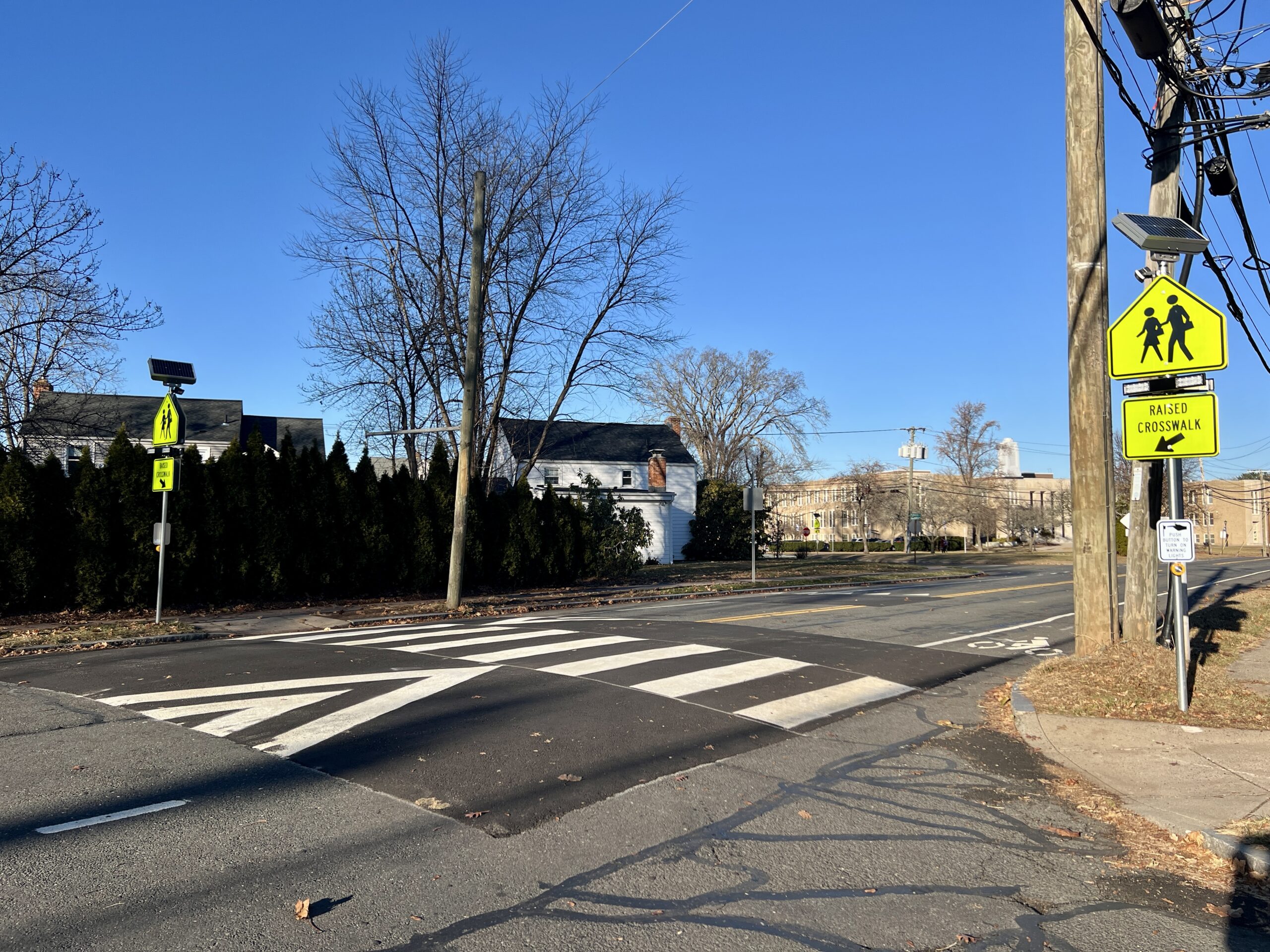
Both a raised crosswalk and Rectangular Rapid Flashing Beacon have been installed at Tunxis Road and Spring Lane. Photo credit: Ronni Newton (we-ha.com file photo)
As West Hartford enters the next phase of implementing Vision Zero, here’s a summary of some upcoming projects, and a list of some terms that you may hear and what they actually mean.
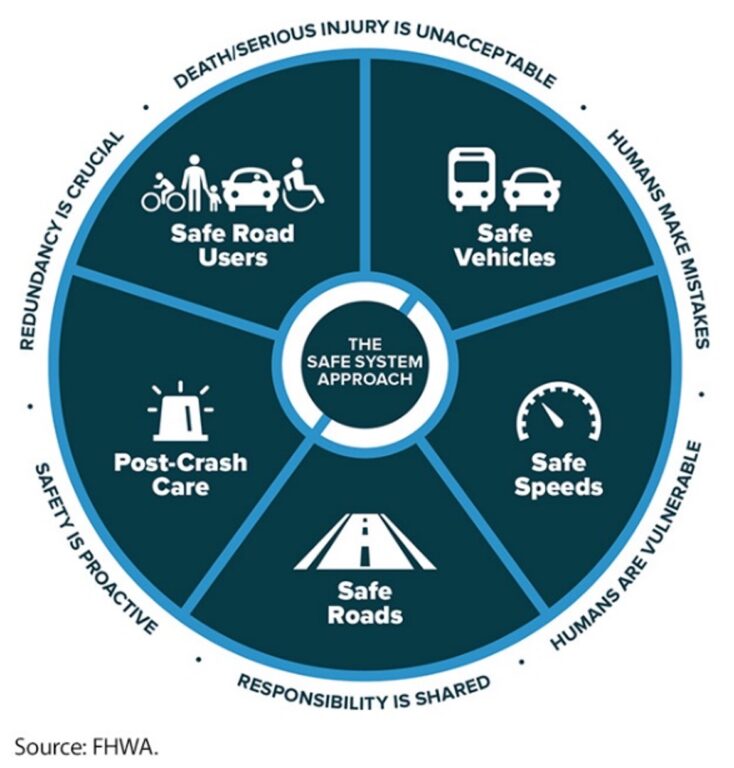
Courtesy image
By Ronni Newton
There has been – and will continue to be – a significant volume of construction work on roads and sidewalks throughout the Town of West Hartford and while much of the work won’t ramp up until the winter is over, planning is underway.
In addition to the seasonal repaving and reconstruction projects, there are a variety of projects being funded by state and federal grants, and another season of implementing many of the items on the Vision Zero Action Plan will also take place.
The West Hartford Town Council adopted the Vision Zero Action Plan on Feb. 27, 2024 – becoming the first municipality in the state to reach the significant milestone toward the ultimate goal of eliminating fatalities and severe injuries on West Hartford streets within 10 years, which would be by 2033. The Action Plan, Town Manager Rick Ledwith said as the Council prepared to vote on its adoption, “focuses on making data driven decisions, redesigning our streets for our most vulnerable users, centering equity in all of our decisions, and engaging our entire community and focusing on accountability.”
Director of Community Development Duane Martin and Town Engineer Greg Sommer will give a complete report on the status of Vision Zero to the Town Council’s Community Planning & Economic Development (CPED) Committee on Feb. 19, but in a recent interview with We-Ha.com shared some highlights.
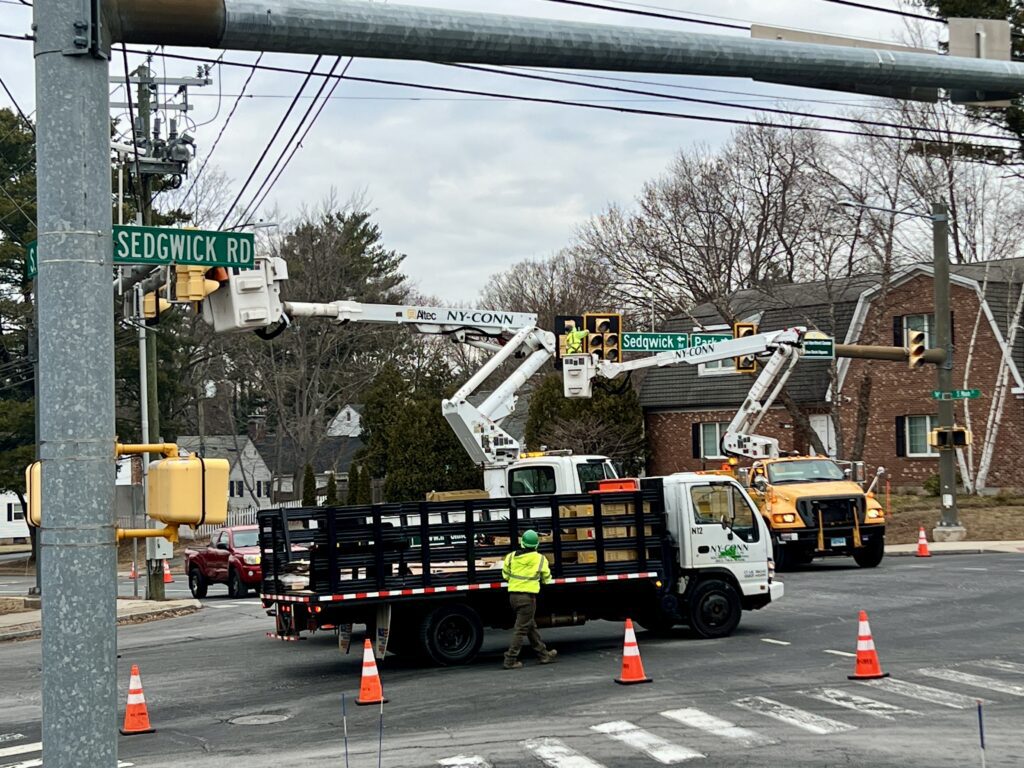
Retroreflective backplates were installed on Jan. 13 at the intersection of South Main Street and Sedgwick/Park roads. Photo credit: Ronni Newton
They also provided an update on the status of the town’s SS4A grant funds, details about RRFB installation, and provided a list of upcoming RSAs. Note: If last sentence seems to be mostly in another language, the acronyms were purposely not defined there, because Martin and Sommer provided a glossary of terms related to Vision Zero and roadway engineering, that readers will hopefully find useful. The list of terms – not all of which are acronyms – and the definitions appear below.
Terms related to Vision Zero:
- Accessible Pedestrian Signals (APS): Devices that provide auditory, visual, and vibrotactile information to pedestrians who are blind or who have low vision, who may also be Deaf or hard of hearing, so they know when the walk signal is on and they may begin to cross at a signalized intersection.
- Concurrent pedestrian phasing: A type of pedestrian signal timing that allows pedestrians to cross at the same time as parallel traffic. This type of phasing can reduce delays for both pedestrians and vehicles. However, it can also create conflicts between pedestrians and turning vehicles.
- Crash: A term used in Vision Zero to describe a traffic incident that resulted in serious injury or fatality.
- Crash Severity: The degree of injury from a crash, including fatality, suspected serious injury, suspected minor injury, possible injury, and property damage only.
- Exclusive pedestrian phasing: A traffic signal timing where all vehicle traffic is stopped at an intersection, allowing pedestrians to cross in any direction simultaneously, essentially giving them exclusive use of the crosswalk.
- High Injury Network: A prioritization tool to focus on streets with crashes resulting in a high number of fatalities and serious injuries.
- KSI Crash: Crashes resulting in someone killed or seriously injured.
- Leading Pedestrian Interval (LPI): A type of pedestrian signal timing that gives pedestrians a head start to cross the street. LPIs are used at intersections with high volumes of pedestrians and turning vehicles.
- Quick Build: A temporary project that is fast and cheap to deploy and demonstrate the value of permanent changes. These projects are intended to enhance pedestrian and cyclist safety, slow traffic speeds, and test new traffic flow patterns and utilize low-cost materials such as paint, signage, temporary barriers or delineators, and planters.
- Raised Intersection/Crosswalk: A road intersection where the entire crossing area is elevated, usually matching the height of the sidewalk, creating a platform that forces vehicles to slow down significantly when passing through, effectively prioritizing pedestrian safety and enhancing visibility at the crossing point.
- Rectangular Rapid-Flashing Beacon (RRFB): A pedestrian-activated device that flashes yellow lights to warn drivers of pedestrians or bicyclists in the crosswalk.
- Retroreflective: A surface or device that reflects light back to its source. Retroreflective materials are used in traffic signs, pavement markings, and personal safety items.
- Road Diet: A roadway reconfiguration which typically involves converting an existing four-lane undivided roadway to a three-lane roadway consisting of two through lanes and a center two-way left-turn lane (TWLTL). A road diet can improve safety, calm traffic, provide better mobility and access for all road users, and enhance overall quality of life.
- Road Safety Audit (RSA): A formal safety performance examination of an existing or future road or intersection by an independent, multidisciplinary team. It qualitatively estimates and reports on potential road safety issues and identifies opportunities for improvements in safety for all road users.
- Safe Streets and Roads for All (SS4A): Federal grant program that supports the U.S. Department of Transportation’s (USDOT) National Roadway Safety Strategy and the goal of zero roadway deaths and serious injuries using a Safe System Approach.
- Safe System approach: A holistic approach to safety that includes safe roads, vehicles, speeds, road users, and post-crash care.
- Speed Reduction Markings: Transverse pavement markings that are used to reduce speeding. They are placed along the edge of the travel lane with decreasing spacing in the direction of travel. The goal is to make drivers perceive that they are traveling faster than they actually are, which encourages them to slow down.
- Traffic Calming: Physical and non-physical measures that reduce the negative effects of motor vehicle use, alter driver behavior, and improve conditions for non-motorized street users while enhancing the environment of the neighborhood.
- Traffic signal backplate: A panel placed behind a traffic light, designed to provide a contrasting background that enhances the visibility of the signal, often featuring a retroreflective border for added visibility at night.
- Transportation Equity Zone (TEZ): An area identified either in a low- or moderate-income Census block group, CT Department of Energy and Environmental Protection environmental justice community, and/or U.S. Department of Transportation equitable transportation community.
- Vision Zero Focus Area (VZFA): A prioritization tool based on the High Injury Network (HIN), Transportation Equity Zone (TEZ), and public comments to guide Vision Zero implementation.
- Vulnerable User: Users who are at higher risk of injury or fatality in the event of a crash, including pedestrians, cyclists, micromobility users, children, and elderly users. They are unprotected by the outside shield of a vehicle and are therefore sustain a greater risk of injury in a collision.
In 2024, Sommer said there were 12 RRFBs installed, and initial plans are for the installation of at least 15 more this year. “We looked at requests, for examples near schools and on collector roads,” Sommer said. Efforts will continue to be made to educate the public on the use of the devices.
“Even if you don’t see a car coming, it’s a good idea to push the button,” said Sommer, and it’s good for motorists to get used to the devices, he added.
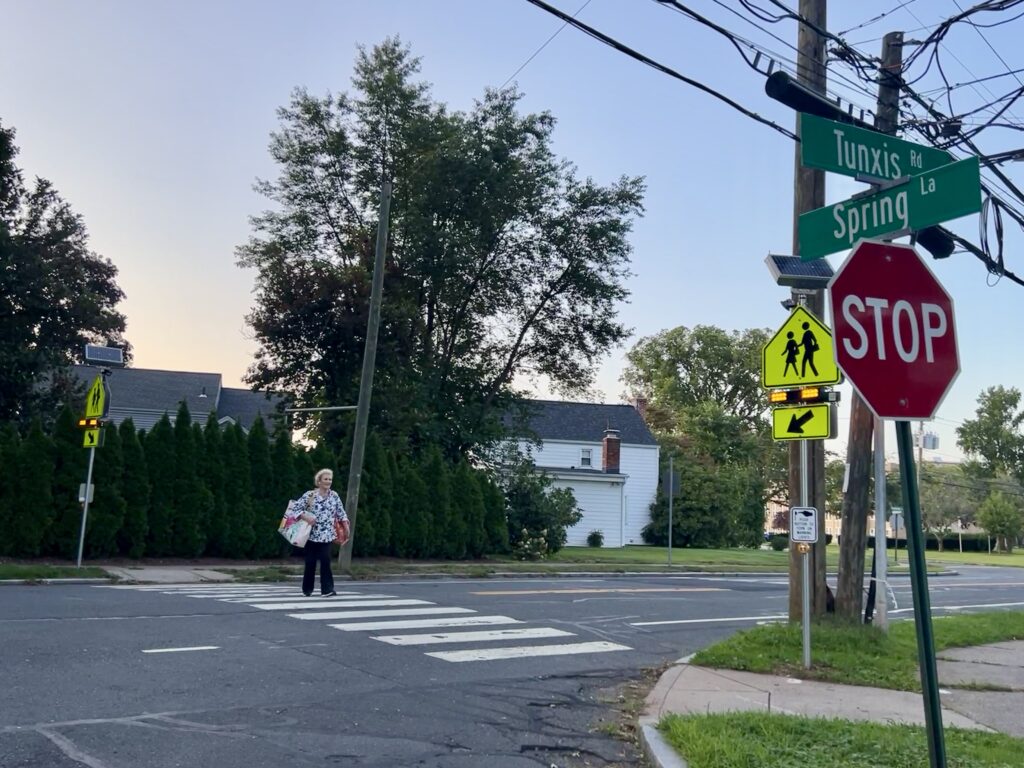
A pedestrian uses the RRFB before crossing Tunxis Road at Spring Lane in August 2024. Photo credit: Ronni Newton (we-ha.com file photo)
The equipment has already been purchased of the installation of RRFBs at:
- Asylum Avenue at Elizabeth Park
- Asylum Avenue at Ballard Drive
- Farmington Avenue at Dover Road
- Fern Street at Cumberland Drive
- Fern Street at Elizabeth Park
- Fern Street at Willowbrook Road
- Flatbush Avenue at the Triumph driveway/soccer fields
- King Philip Drive at King Philip Middle School
- Mountain Road at Apple Hill Road
- North Main Street at Wampanoag Drive
- North Main Street at Huron Drive
- Oakwood Avenue at Sidney Avenue
- Oakwood Avenue at St. James Street
- Trout Brook Drive at Jackson Avenue
- Webster Hill Boulevard at Carleton Road
An additional set of warning lights will be added in advance of the existing RRFB on North Main Street near Wyndwood Road, Sommer said. Those lights will also flash when a pedestrian activates the RRFB button, to give drivers more time to stop.
Speed reduction markings which provide an optical illusion that slows traffic, like those on Tunxis Road between Ridgewood Road and Wardwell Road, will be added on Flagg Road and Steele Road.

Markings on the pavement on Tunxis Road visually narrow the roadway and are intended to slow traffic. Photo credit: Ronni Newton (we-ha.com file photo)
At Boulevard and South Quaker Lane, there is currently a button that pedestrians can push before crossing the street – but no walk light. Sommer said while it’s not apparent to most, pushing the walk button will extend the green light for a pedestrian to have more time to cross the road. There are plans, he added, for a signal with an LPI to be added at that location.
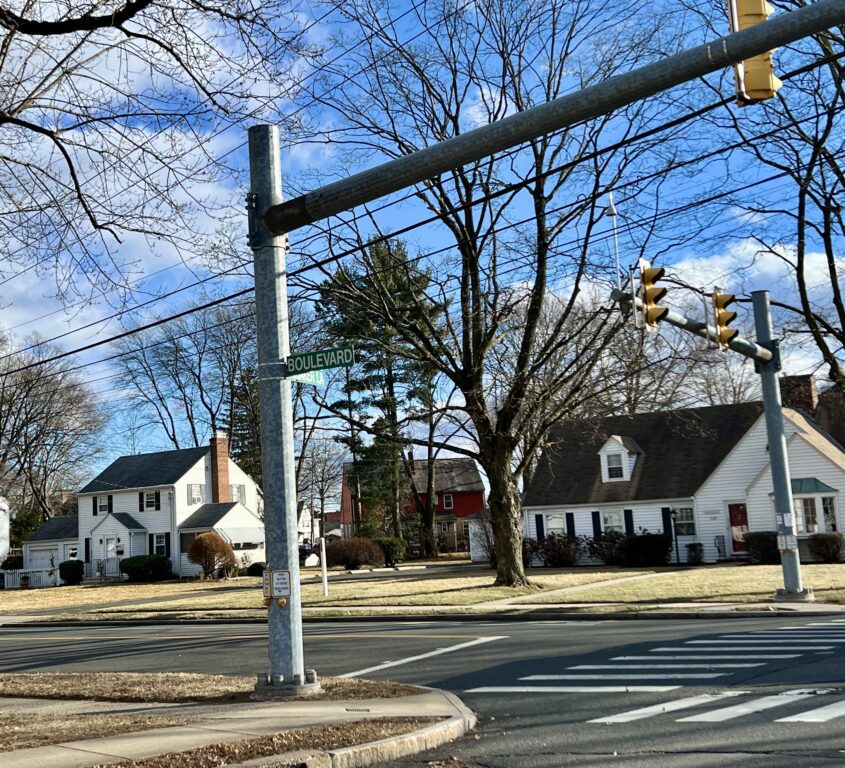
The “walk” button at Boulevard and South Quaker does extend the green light for pedestrians, but addition of a signal is in the plans. Photo credit: Ronni Newton
Another traffic calming measure – touted as a successful means of slowing drivers by Ed Pawlak, chair of the Pedestrian & Bicycle Commission at a recent Town Council meeting – is raised crosswalks. The first one was installed on Boulevard at Wardwell, and he said it has slowed the average speed by 26%. “Our position is that the town should be rolling these out all across town,” Pawlak, said, noting that at a cost of $10,000 to $15,000, they won’t “break the bank.”
Plans for the installation of additional raised crosswalks will be included in the Vision Zero report at the CPED meeting later this month.
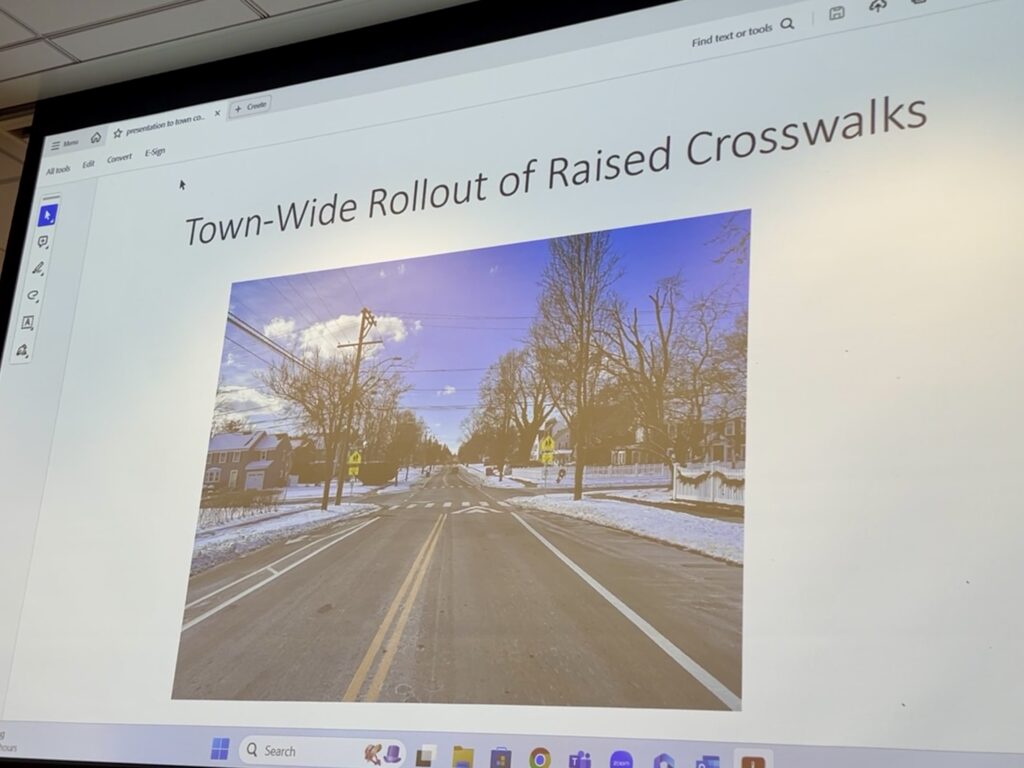
Ed Pawlak, chair of the Pedestrian & Bicycle Commission, speaks to the Town Council on Jan. 28 about the benefit of raised crosswalks. Photo credit: Ronni Newton
“We’re not working on just these little silo projects, we’re looking at the big picture,” Martin said.
Vision Zero is intended to be a holistic approach to making the roadways safer for all users, and Road Safety Audits are an important means of gathering input and determining the Vision Zero Focus Areas.
There are plans to conduct RSAs on the following stretches of roadway:
- South/North Main Street from Webster Hill Boulevard to Loomis Drive
- North Main Street from Asylum Avenue to Huron Drive
- Farmington Avenue from Westland Avenue to Whiting Lane
- New Britain Avenue from Mayflower Street to the Hartford city line
Further details about speed enforcement cameras and red light cameras, as well as other safety-related measures, will be provided in the report to CPED.
Like what you see here? Click here to subscribe to We-Ha’s newsletter so you’ll always be in the know about what’s happening in West Hartford! Click the blue button below to become a supporter of We-Ha.com and our efforts to continue producing quality journalism.


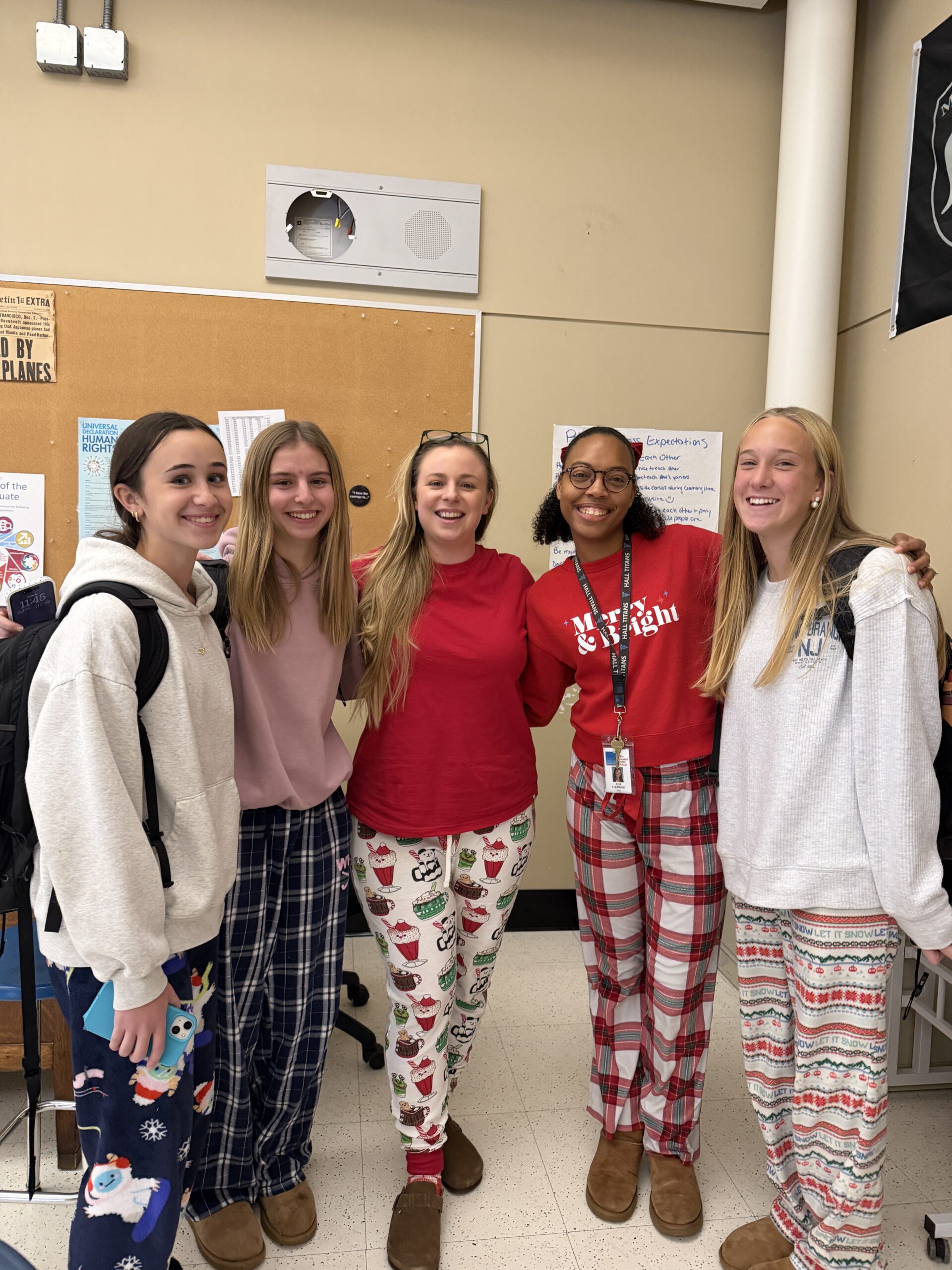

all these vision zero terms mean that they are a scam designed to surveil the people. I can’t even get honest comments out of our town officials that’s why I stopped trying to communicate with them on this topic. Certain the powers that be wanted to debate about the meaning of words with me last fall, whether it be traffic cameras are red light cameras and which camera is the ACLU of Connecticut opposed (even though I have an email directly from the leader of the ACLU in Connecticut saying that the organization has serious concerns about these cameras). I have also talked to other business owners in town who would traditionally be considered racial minorities. The word on the street that that I’m getting is that the cameras are just a woke political ploy. The leaders of this town hope that a lot of white people get caught on camera so that it sort of evens out the alleged racist policing of the past. (which is something that I don’t believe at all) . Of course they’ll never admit this. The ultimate proof of whether these cameras are worth it or not will be a year or two down the road when the demographic data of the tickets issued can be analyzed.
Thank you Mrs. Newton for another detailed report.
In my 40 years living in West Hartford I feel speed limits are inadequately enforced. I set my car to do the speed limit in residential areas. I frequently get honked at by drivers behind me or they tailgate or blink their high beams. In warmer weather I often get the finger.
Fortunately the amount of daylight is increasing but in the short daylight period before and after the winter solstice people walking need to wear lights or reflective vests.
Computerized policing is wrong. Constant monitoring of the populace in the course of their day is wrong. The govt having the ability to know where everyone is all the time is evil and a recipe for authoritarianism. If the stasi would love what you’re doing then you’re doing it wrong.
Red light and speed limit cameras have greatly reduced vehicle crashes, driver caused deaths and serious injuries all across Europe. If you want to help protect the life and safety of your friends and family members start using efficient, modern technology to save thousands of lives and serious injuries. I’m threatened each week by racing drivers going through red lights. They don’t even slow down while the walk lights are on, when I want to cross New Britain Ave. at Quaker Lane. There are hundreds of such violations every day at this one location.
I will be surprised if no pedestrians or even vehicle occupants are not killed along New Britain Ave. in the next 2 or 3 years between Mayflower and the Hartford Line. Our knowledgeable Police officers and area pedestrians and drivers can tell you that this stretch of road is a potential death zone. No STUDY is needed; tax money need be wasted on further study. Just start enforcing the hundreds of daily speeding and red light violations happening there. The Camera systems will show all those drivers not stopping; not even slowing to turn right. And going straight through red lights!